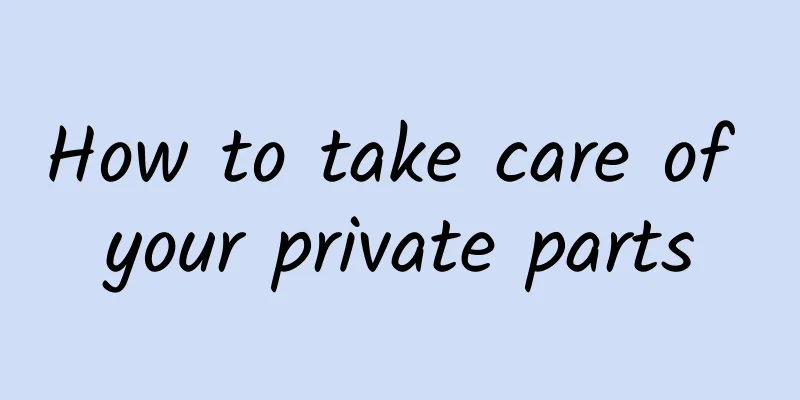What are the symptoms of a bloated baby?

|
A bloated belly is a very common phenomenon in babies as they grow. Since babies are too young and their digestive systems are not fully developed, they are very prone to bloating. Moreover, since babies cannot speak, they can only express their discomfort by crying. Therefore, parents must be very careful when taking care of their babies and observe their babies more often. So what are the symptoms of a bloated belly in babies? Symptoms of bloating in baby Uneasy sleep When sleeping, he would curl up his hands and legs, making sounds of straining, and sometimes his face would turn red. You may think your baby is asleep when you hold him/her, but he/she wakes up immediately when you put him/her down. If most babies like to sleep in your arms, you should consider that it may be due to bloating. When babies kick their legs, they actually want to massage their stomachs, and parents can solve the massage problem by holding them. You can use a sling at this time, so that adults will not be very tired. Love lying down and crying Sudden and violent crying. It will be a little quieter when lying on the stomach. Not honest when drinking milk Always kicking legs or pulling nipples (please distinguish between nipple confusion and growth spurt); if feeding on the side, the baby may keep kicking legs and then jump up; Keep eating Every time the baby stops crying after sucking the nipple, the family thinks that the baby may be hungry. In fact, the baby has found a way to comfort himself. However, eating too much will aggravate bloating. Farting and defecation Some babies will fart, which is a typical sign of flatulence. Usually the symptoms of bloating are relieved after the baby passes gas and has a bowel movement. Solutions for baby's bloating 1. You can try the airplane hold or help your baby do body movements 2. Let your child lie on his stomach more often, or on an adult's belly; 3. Massage your baby's belly in a clockwise direction; 4. Parents hold the baby's legs and pedal like a bicycle; 5. You can give your child some probiotics to supplement beneficial intestinal bacteria, help digestion, and facilitate gas discharge. What is baby skin erythema? Erythema on infant skin is usually a physiological reaction of the newborn's skin, but erythema on infant skin may be a hemangioma. The most common types of hemangiomas are: 1. Orange spots. The patches are present at birth and vary in size. They are orange-red or light red in color, not protruding above the surface of the skin, and fade when pressed lightly. Their color deepens when the baby cries. Orange spots are often seen on the forehead, upper eyelids and occipital region. They usually disappear on their own within a few months after birth and do not require any treatment. 2. Erythematous nevus. Also known as port wine stain. It exists at birth and is a light red or dark red patch that does not fade when pressed. It does not protrude above the surface of the skin. It is located in the dermis and is composed of a network of capillaries. After birth, the nevus erythematosus grows in proportion to the body's growth but no longer expands in area. Erythematous nevus cannot disappear on its own. Apart from affecting the appearance, erythematous nevus generally has no other harm, and cryosurgery can be used when necessary. 3. Capillary hemangioma. They are mostly found on the skin, especially on the occipital area, head, face, limbs and back, and many grow on the lips and tongue. Capillary hemangiomas vary in size, with large ones occupying large areas of the face or limbs and small ones being only a few millimeters and slightly above the skin. Capillary hemangiomas usually exist at birth, grow rapidly within 6 months, and gradually stop growing after one or two years of age. It affects the appearance and there is a risk of heavy bleeding if it is damaged, so parents should pay close attention. |
>>: What is the reason for girls’ bloating?
Recommend
What causes recurring colds?
The weather is hot and cold, and many people will...
What is potassium dihydrogen sulfate used for?
Potassium dihydrogen sulfate is widely used in th...
Seasonal urticaria
Speaking of urticaria, I believe that everyone wi...
What are the effects of external application of Astragalus on the skin?
As a traditional Chinese medicine, Astragalus is ...
Detailed explanation of how TCM treats molluscum contagiosum
Molluscum contagiosum is a relatively common infe...
Pneumonia Chinese medicine
The lungs are a dominant organ in the respiratory...
Causes of bad breath
In terms of body maintenance, we need good method...
What to do if the wound on the face becomes festering
The face is the most important part of our body, ...
Irregular menstruation
The irregular menstruation that we often talk abo...
Why do elderly people have leg pain?
Leg pain in the elderly should certainly not be i...
Epilepsy symptoms
Epilepsy, which is what people often call epileps...
Whooping cough symptoms and treatment in infants
Whooping cough is a relatively common infant dise...
Effects of Xiaoyao Pills
People only have one life, and it is also very fr...
What causes kidney stones?
Kidney stones are a type of kidney disease in our...
Is it good to have a mole on the philtrum? What is the difference between men and women?
The philtrum is located below the nose and on the...









